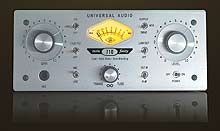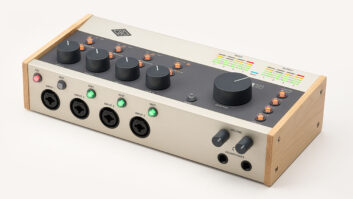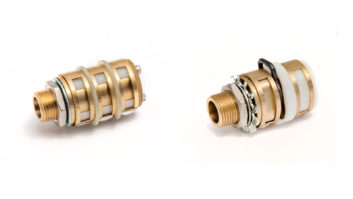
Click here for a Flash graphic” />
The Twin-Finity provides input and output level control, plus variable tube/solid-state signal paths.
Click here for a Flash graphic
The front end of the audio chain — aka, the mic preamp — is a great place to introduce some color to your signal. The UA 710 Twin-Finity preamp does just that with its new twist on tube-plus vs. solid-state signal paths. Dual-path architecture is nothing new: Millennia, Manley, Aphex and SSL all offer great products with variations on that theme. What’s new here is the ability to traverse from either or to infinite stages between the two personalities of the paths.
The single-channel 710 Twin-Finity can be used on the desktop or rackmounted side-by-side with another 710. You can also purchase a handle kit should you want to carry it around more conveniently. The controls are self-explanitory with a couple of exceptions. Features include 70 dB of gain via large input gain and output level knobs, switchable phantom power, -15dB pad, highpass filter (75 Hz), polarity invert and mic vs. line operation.
One of the better features is the innovative Drive vs. Output meter switching. If Output is chosen, the meter reads the unit’s output, as you’d expect. However, if Drive is chosen, the meter provides a rough idea of how hard you’re hitting the tube/sold-state stage: 0 dB is equal to 1.2-percent THD (at 1kHz). while -10 dB is 0.4 percent. I found this most useful when switching it back and forth between the two modes while adjusting the Blend knob and gain/level controls until the color and output level are just right. Another great feature, the Blend knob is infinitely variable between 100-percent tube and 100-percent solid-state — all phase-coherent. With the gain/level adjustments, that gives you nearly limitless control over tube crunch and overdrive.
On the Bench
I ran a variety of tests of the 710 using an Audio Precision APx525 system. One of the best features of the 710 is the Drive setting on the meter, which lets you see how much distortion you’re introducing to your signal. So I first looked at how accurate the meter’s Drive setting was and found that the unit delivered as advertised. At 1 kHz at rated output (+4 dB) with the meter reading “0,” the tube or solid-state paths measured 1.36-percent total THD+Noise. (UA measured 1.4 percent.)
Next, I measured frequency response at various settings of input Gain vs. Level. At the rated output (+4 dB), the solid-state path’s deviation from 20 to 80 kHz was never more than 0.562 dB and never less than 0.5 dB (at 1 kHz ref. level). The tube side was within 0.04 dB of that figure. For more measurements and interactive graphics, be sure to visit mixonline.com.
Between the Twin Paths
I first used the 710 on a 6-string active bass guitar fed through the mic panel after visiting a Radial JDI passive direct box. At first listen, the feed was distorted when the player hit it hard, but a quick 9-volt battery change in the instrument fixed that. Using the Blend knob, I could hear the 710 go to work on the tone with the bass in the track. What’s nice about this feature? It can instantly audition the tube’s influence on the track by sweeping the knob from left to right, providing a nearly endless variety of options. In use, the tube path sounded weaker in level than the solid-state, but when measured on an Audio Precision APx525 test system at 1 kHz and 100 Hz, it showed only a 0.2dB gain change. This was surprising because I had to boost the gain to get the track’s perceived level up in the mix when going with the tube side.
I next employed the unit on two drum sessions, first powering a Shure Beta 52 inside the kick and later on an SM57 placed on the snare. On the kick track, I could really hear the benefits of the twin paths. With the Trans/Tube knob turned completely counter-clockwise (Trans), the kick had a lot of clean and punchy transient attack. Then, by slowly sweeping it to the right, I could start to hear the tube’s effect when the attack became more rounded as the bottom end increased. The hard-right setting muted the attack too much, so I finally left the knob at 12 o’clock where the kick exhibited the perfect ratio of bottom punch vs. attack. On the snare, I parked the Blend at 1 o’clock and relied more on the Gain vs. Level controls to alter the sound. While switching the meter between Drive and Output, I played with gain and level settings until I had the sound I was after. At first, the meter switching is a bit odd, but it’s a great way to verify distortion and “learn” the unit with your ear. By turning up the gain, I could flatten the snare out in the track — almost compressing it.
If you work with vocalists who exhibit a wide tonal range, the 710 could be your tool of tools. On two different sessions, I could shift the color of the vocal around so it matched the track perfectly. By adding a bit of tube flavor, I could take the edge off a strident male vocalist who had a sharp edge to his tone, while on more mellow vocalists, setting the 710 completely on the solid-state side made the track pop out more in the mix.
Just the Ticket
I used the 710 on a variety of sessions and instruments with great results. Across the board it offered a wide array of sonic options, whether I was looking for a clean sound or something with more, or a lot more analog distortion. For bass, it sounded equally as good whether I plugged the bass in direct in the control room with a guitar cable or routed the input through a DI into the mic input from the next room. The 710 was brilliant on kick, snare and vocals, giving me a wide palette of tonal options to play with — all in short order. Anyone looking for a favorable feature-to-dollar ratio in a mic preamp should strongly consider the Universal Audio 710. It’s an expert tone-blender and DI at a decent price.
Kevin Becka is the technical editor of Mix.








